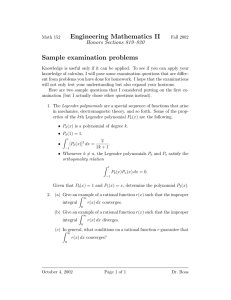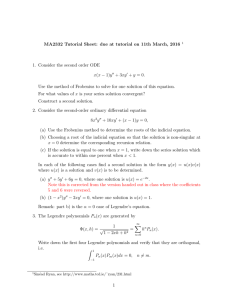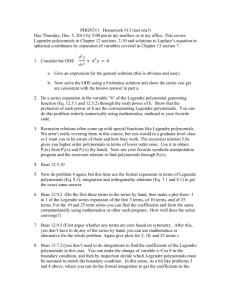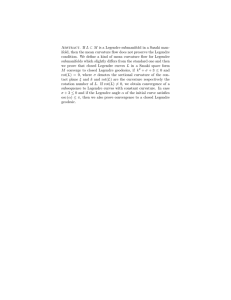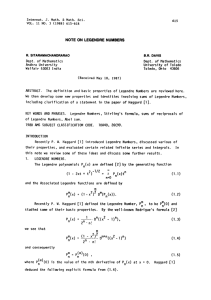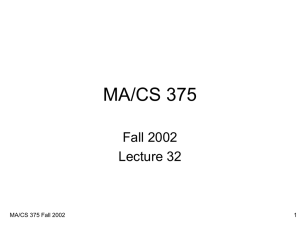Chapter5
advertisement
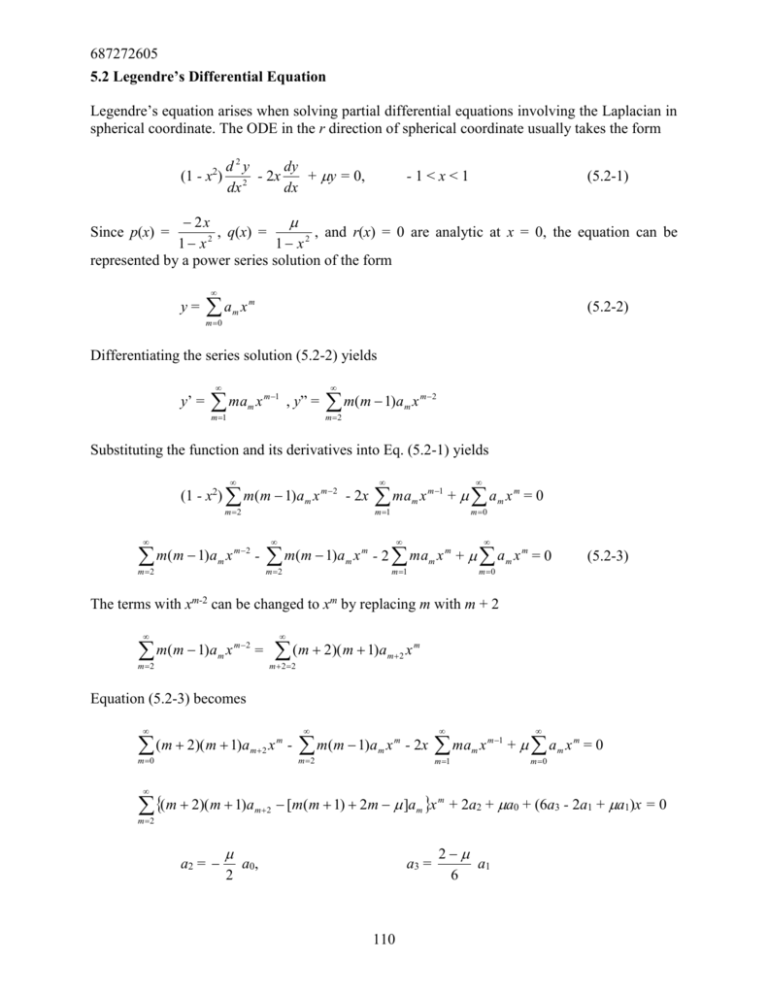
687272605 5.2 Legendre’s Differential Equation Legendre’s equation arises when solving partial differential equations involving the Laplacian in spherical coordinate. The ODE in the r direction of spherical coordinate usually takes the form dy d2y (1 - x ) 2 - 2x + y = 0, dx dx 2 -1<x<1 (5.2-1) 2x , q(x) = , and r(x) = 0 are analytic at x = 0, the equation can be 2 1 x 1 x2 represented by a power series solution of the form Since p(x) = y= a m 0 m xm (5.2-2) Differentiating the series solution (5.2-2) yields y’ = mam x m1 , y” = m 1 m(m 1)a m x m 2 m 2 Substituting the function and its derivatives into Eq. (5.2-1) yields (1 - x2) m( m 1)a m x m 2 - 2x m 2 m(m 1)am x m2 - m 2 m 1 m 0 mam x m1 + a m x m = 0 m 2 m 1 m 0 m(m 1)am x m - 2 mam x m + a m x m = 0 (5.2-3) The terms with xm-2 can be changed to xm by replacing m with m + 2 m(m 1)am x m2 = m 2 (m 2)( m 1)a m2 xm m 22 Equation (5.2-3) becomes (m 2)( m 1)am2 x m - m 0 (m 2)( m 1)a m2 m(m 1)am x m - 2x m 2 m 1 m 0 mam x m1 + a m x m = 0 [m( m 1) 2m ]a m x m + 2a2 + a0 + (6a3 - 2a1 + a1)x = 0 m 2 a2 = a0 , 2 a3 = 110 2 a1 6 687272605 am+2 = m( m 1) am ( m 2)( m 1) ( n m)( n m 1) m(m 1) n 2 n am = am ( m 2)( m 1) (m 2)( m 1) For = n ( n 1) am+2 = ( n 1)( n 2) a1 3! a2 = n( n 1) a0 2! a4 = ( n 2)( n 3) ( n 2)n ( n 1)( n 3) a2 = a0 3 4 4! a5 = ( n 3)( n 4) ( n 3)( n 1)( n 2)( n 4) a3 = a1 45 5! a3 = The general solution is then y (x ) = a0y1 (x ) + a1y2 (x ) where y1 (x ) = 1 n( n 1) 2 ( n 2)n ( n 1)( n 3) 2 x + x ... 2! 4! y2 (x ) = x ( n 1)( n 2) 3 ( n 3)( n 1)( n 2)( n 4) 5 x + x + ... 3! 5! If n is an even integer then (when m = n) an+2 = - ( n n )( n n 1) an = 0 = an+4 = an+6 = ... ( n 2)( n 1) 2( 3) 2 x = 1 3x2 2! If n = 2, y1 (x ) = 1 If n = 4, y1 (x ) = 1 10x2 + 35 4 x 3 If n is an even integer then y1 (x ) is a polynomial of degree n, and y2 (x ) has the form of an infinite series. Similarly, if n is an odd integer then y2 (x ) is a polynomial of degree n, and y1 (x ) is an infinite series. If n = 1, y2 (x ) = x If n = 3, y2 (x ) = x 5 3 x 3 111 687272605 If n = 5, y2 (x ) = x 14 3 21 5 x + x 3 5 For the polynomial solutions, the non-vanishing coefficients can be expressed in terms of the coefficients an of the highest power of x of the polynomial. We need a backward recurrence relation that takes us from am to am-2. From the recurrence relation am+2 = - ( n m)( n m 1) am ( m 2)( m 1) Replacing m by m – 2 yields am = - ( n m 2)( n m 1) am-2 m( m 1) The backward recurrence relation becomes am-2 = - m( m 1) am ( n m 2)( n m 1) an-2 = - n( n 1) an 2( 2n 1) For m = n, ( 2n )! so that all the 2 n ( n! ) 2 polynomials will have the value unity at x = 1. It we do that, the polynomials are called Legendre polynomials of degree n: Pn(x) The coefficient an is still arbitrary. It is standard to choose an = Pn(x) = where 1 2n M (1) m 0 m (2n 2m)! xn-2m m! (n m)! (n 2m)! M = n/2 if n is even, and M = (n – 1)/2 if n is odd. The first few Legendre polynomials are P0(x) = 1 P1(x) = x P2(x) = 1 (3x2 1) 2 P3(x) = 1 (5x3 3x) 2 P4(x) = 1 (35x4 30x2 + 3) 8 P5(x) = 1 (63x5 70x3 + 15x) 8 In summary: For n = 0, 1, 2, ... the Legrendre equation of order n 112 687272605 dy d2y (1 - x ) 2 - 2x + n(n + 1)y = 0, dx dx 2 -1<x<1 has two linearly independent solutions y1 (x ) and y2 (x ) y1 (x ) = 1 n( n 1) 2 ( n 2)n ( n 1)( n 3) 2 x + x ... 2! 4! y2 (x ) = x ( n 1)( n 2) 3 ( n 3)( n 1)( n 2)( n 4) 5 x + x + ... 3! 5! When n is an even integer y1 is a polynomial Pn(x) of degree n and y2 has the form of an infinite series. Legendre’s function of the second kind is defined as Qn(x) = y1 (x ) y2 (x ) n even When n is an odd integer y2 is a polynomial Pn(x) of degree n and y1 has the form of an infinite series. Legendre’s function of the second kind for this case is defined as Qn(x) = - y1 (x ) y2 (x ) n odd The general solution of Legrendre equation is then y (x ) = C1 Pn(x) + C2 Qn(x) Legendre function of the second kind converges on the interval - 1 < x < 1 and diverges at the end points. The first few Legendre functions of the second kind are Q0(x) = 1 1 x ln 2 1 x Q1(x) = x Q0(x) 1 Q2(x) = P2(x)Q0(x) 3 x 2 Q3(x) = P3(x)Q0(x) 5 2 2 x + 2 3 Q4(x) = P4(x)Q0(x) 35 3 55 x + x 24 8 Q5(x) = P5(x)Q0(x) 63 4 49 2 8 x + x 8 15 8 113
